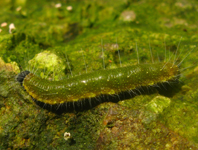Abstract
The polytypic Straight-billed Woodcreeper Dendroplex picus (J. F. Gmelin, 1788) is one of the most complex species-groups of Dendrocolaptidae (Aves: Passeriformes), from both the nomenclatural and morphological standpoints. Firstly, its alpha taxonomy is debatable. Virtually all recent works (e.g. Aleixo 2002; Marantz et al. 2003; del Hoyo & Collar 2016) have recognized just two species in the group—Dendroplex picus and Zimmer’s Woodcreeper Dendroplex kienerii (Des Murs, 1856)—although some of the other described taxa possess singular morphological characters and well-defined ranges somewhat isolated from their geographically closest relatives (e.g. Plain-throated Woodcreeper Dendroplex picirostris Lafresnaye, 1847). Secondly, the correct genus to which to allocate taxa presently included in this group (vide Aleixo 2002) has been controversial. There is a considerable confusion as to which nominal species should be regarded as the type of Dendroplex Swainson, 1827b. Three species are involved in the dispute (Cory & Hellmayr 1925; Peters 1951; Aleixo et al. 2002; Marantz et al. 2003; Aleixo et al. 2007): Oriolus picus J. F. Gmelin, 1788; Dendrocolaptes guttatus M. H. C. Lichtenstein, 1818; and Dendrocolaptes ocellatus Spix, 1824. Here, we re-examine the nomenclatural issue and show that application of the nomen Dendroplex to the clade comprising the species-group D. picus (Aleixo et al. 2007) is based on a misunderstanding of the application of Article 70.3 of the Code (Anon. 1999) and that Dendrocolaptes ocellatus Spix, 1824, is its real type species. Consequently, the genus Dendroplex Swainson, 1827b, must be considered a junior synonym of Xiphorhynchus Swainson, 1827a. Because no generic nomen is currently available for them, we propose a new genus nomen to encompass the species originally described as Oriolus picus J. F. Gmelin, 1788, Dendroplex picirostris Lafresnaye, 1847, and Dendrornis kienerii Des Murs, 1856.
References
Aleixo, A. (2002) Molecular systematics and the role of the “várzea” – “terra-firme” ecotone in the diversification of Xiphorhynchus woodcreepers (Aves: Dendrocolaptidae). Auk, 119, 621–640.
Aleixo, A., Gregory, S.M.S. & Penhallurick, J. (2007) Fixation of the type species and revalidation of the genus Dendroplex Swainson, 1827 (Dendrocolaptidae). Bulletin of the British Ornithologists’ Club, 127, 242–246.
Anon. [International Commission on Zoological Nomenclature] (1999) International Code of Zoological Nomenclature. Fourth edition. International Trust for Zoological Nomenclature, London, 306 pp.
Buffon, G.L.L. (1783) Histoire Naturelle des Oiseaux. Vol. 7. L’imprimerie Royale, Paris, 683 pp.
Cory, C.B. & Hellmayr, C.E. (1925) Catalogue of birds of the Americas. Zoological Series. Vol 13. Part 4. Field Museum of Natural History, Chicago, 390 pp.
Cuvier, G.L.C.F.D. (1829) Le règne animal distribué d'après son organisation, pour servir de base à l'histoire naturelle des animaux et d'introduction à l'anatomie comparée. Tome I. Nouvelle Edition. Revue et Augmentée. Déterville and Crochard, Paris, xxxviii + 584 pp.
Dickinson, E.C. Overstreet, L.K., Dowsett, R.J. & Bruce, M.D. (2011) Priority! The Dating of Scientific Names in Ornithology: a Directory to the Literature and its Reviewers. Aves Press, Northampton, 319 pp.
Dubois, A. (2005) Proposed rules for the incorporation of nomina of higher-ranked zoological taxa in the International Code of Zoological Nomenclature. 1. Some general questions, concepts and terms of biological nomenclature. Zoosystema, 27 (2), 365–426.
Dubois, A. (2010) Retroactive changes should be introduced in the Code only with great care: problems related to the spellings of nomina. Zootaxa, 2426, 1–42.
Dubois, A. (2011) The International Code of Zoological Nomenclature must be drastically improved before it is too late. Bionomina, 2, 1–104.
https://doi.org/10.11646/bionomina.2.1.1
Feduccia, A. (1973) Evolutionary trends in the Neotropical Ovenbirds and Woodhewers. Ornithological Monographs, 13, 1–69.
https://doi.org/10.2307/40166692
Griffith, E. & others. (1829) The Animal Kingdom arranged in conformity with its organization, by the Baron Cuvier, with additional descriptions of all the species hitherto named and of many not before noticed. Vol. 7. Whittaker, Treacher & Co., London, 586 pp.
del Hoyo, J. & Collar, N. (2016) HBW and Birdlife International Illustrated Checklist of the Birds of the World, 2, Passerines. Lynx Edicions, Barcelona, 1013 pp.
Marantz, C.A., Aleixo, A., Bevier, L.R. & Patten, M.A. (2003) Family Dendrocolaptidae (woodcreepers). In: del Hoyo, J., Elliott, A. & Christie, D.A. (Eds.), Handbook of the birds of the world. Vol. 8. Lynx Edicions, Barcelona, pp. 358–447.
Oberholser, H.C. (1905) Notes on the nomenclature of certain genera of birds. Smithsonian Miscellaneous Collections, 48, 59–68.
Peters, J.L. (1951) Check-list of birds of the world. Vol. 7. Museum of Comparative Zoology, Harvard University, Cambridge, Massachusetts, 318 pp.
Raposo, M.A., Höfling, E., Gaban-Lima, R., Stopiglia, R. & Formozo, P. (2006) Anatomia da siringe dos Dendrocolaptidae (Aves, Passeriformes). Arquivos do Museu Nacional, 64 (2), 181–191.
Raposo, M.A., Kirwan, G.M., Assis,C.P., Höfling, E. & Stopiglia,R. (2018) Alpha taxonomy of the genus Paludicolaptes (Aves: Passeriformes: Dendrocolaptidae). [in preparation]
Spix, J.B. von (1824) Avium species novae, quas in itinere per Brasiliam annis MDCCCXVII–MDCCCXX […] collegit et descripsit. Vol. 1. Franc. Seraph. Hübschmann, Monachii [Munich], [VII] + 90 pp., 91 pls.
Swainson, W. (1827a) Synopsis of the birds discovered in Mexico by W. Bullock, F.L.S. and H.S., and Mr. William Bullock, jun. [Concluded from p. 369.] Philosophical Magazine and Annals of Philosophy, 1 (1), 433–442.
https://doi.org/10.1080/14786442708674357
Swainson, W. (1827b) On several groups and forms in ornithology, not hitherto defined. [Concluded from p. 175.]. Zoological Journal, 3 (11), 343–363.
Swainson, W. (1830) Observations on several of the genera and species of the Order Passeres of Cuvier. In: Griffith, E. & others, The Animal Kingdom arranged in conformity with its organization, by the Baron Cuvier, with additional descriptions of all the species hitherto named and of many not before noticed. Vol. 8. Whittaker, Treacher & Co., London, pp. 677–690.
Swainson, W. (1837) On the Natural History and Classification of Birds. Vol. 2. Longmans, Brown, Green & Longmans, London, 398 pp.

